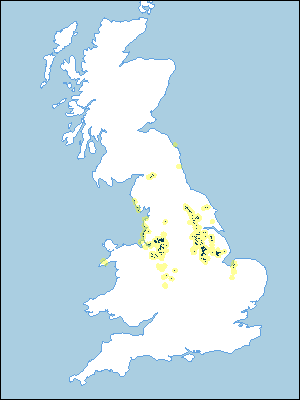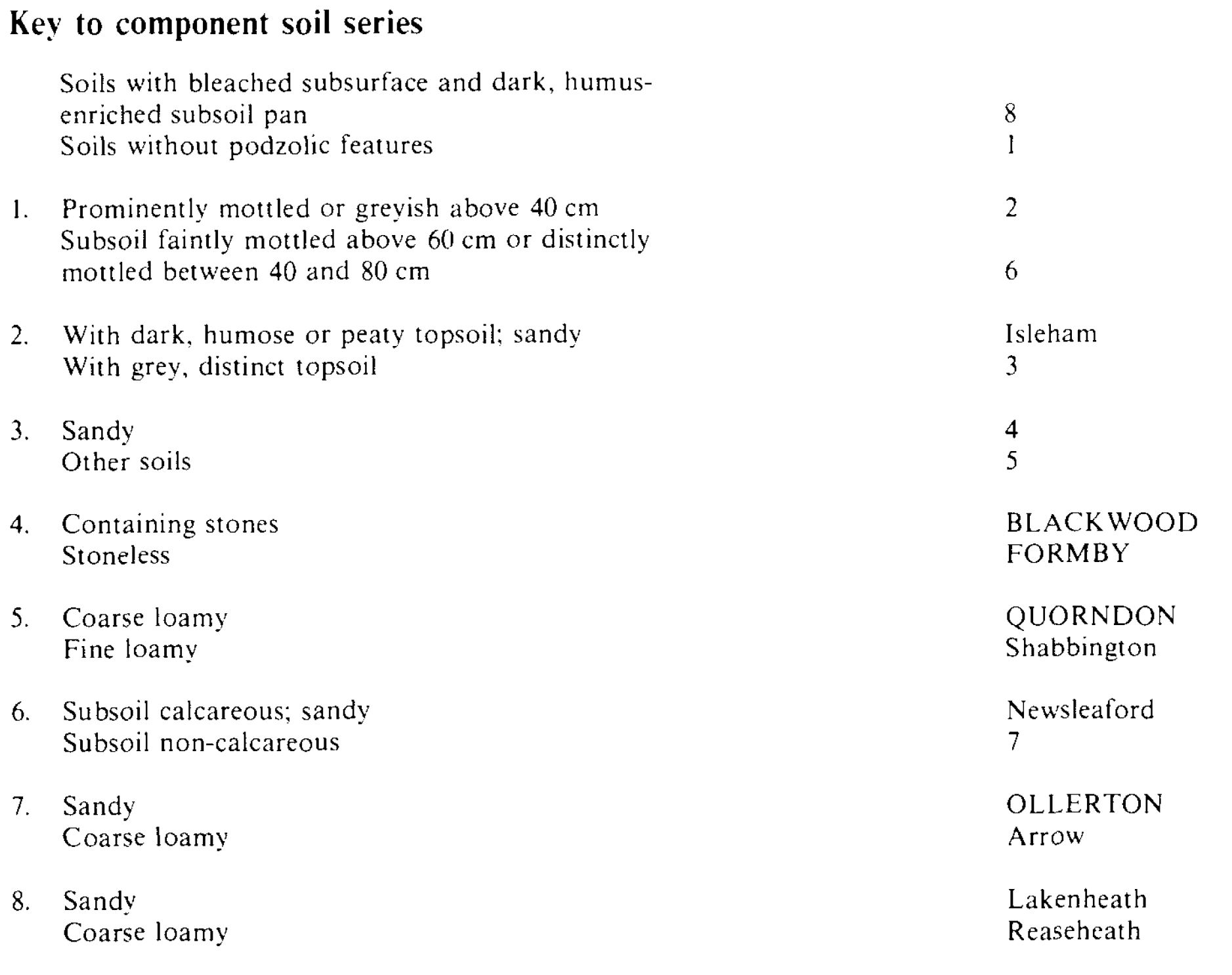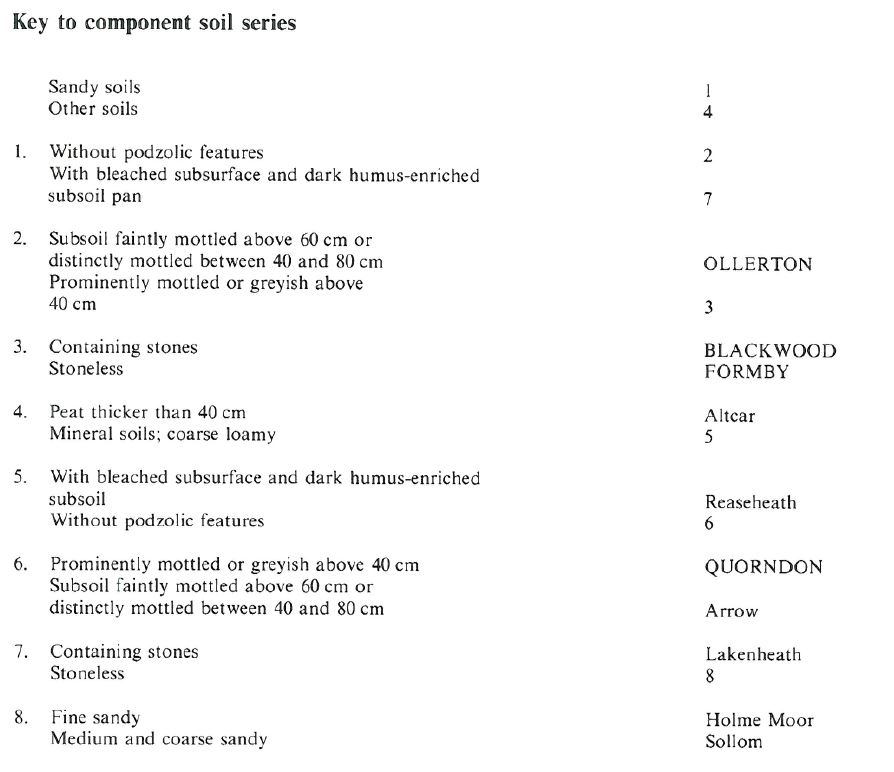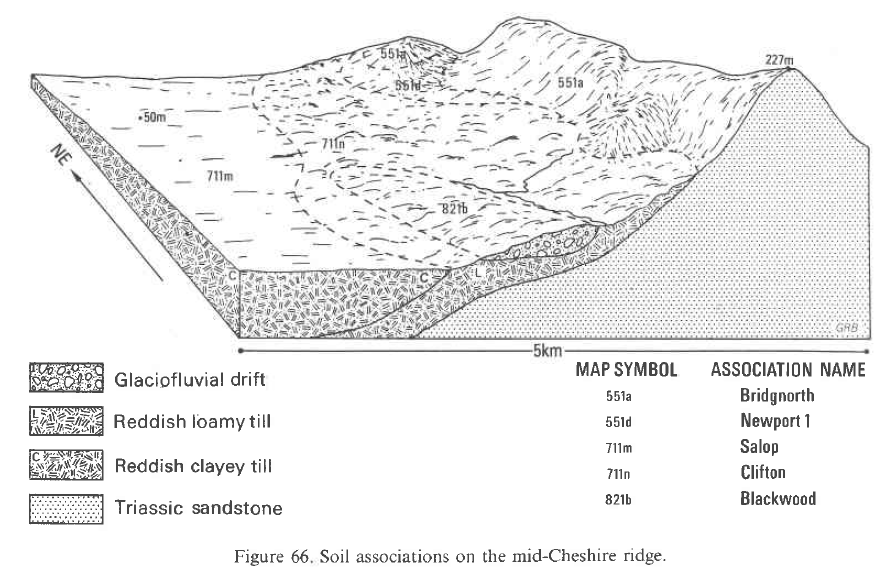
Soil Associations
0821b BLACKWOOD
Soil and site characteristics
Deep permeable sandy and coarse loamy soils. Groundwater controlled by ditches.
Geology
Glaciofluvial drift
Cropping and Land Use
Cereals; potatoes and sugar beet; some grassland and coniferous woodland.
Component soil series
| Subgroup | Series name | Percentage | WRB 2006 link |
|---|---|---|---|
| 8.21 | BLACKWOOD | 52% | Arenic Mollic Gleysols |
| 8.31 | QUORNDON | 29% | Eutric Gleysols |
| 8.21 | FORMBY | 10% | Arenic Eutric Gleysols |
| 5.52 | OLLERTON | 9% | Eutric Endogleyic Arenosols |
Covers 1219 km2 in England and Wales
Soilscapes Classification
| 15 |
Naturally wet very acid sandy and loamy soils |
0821b BLACKWOOD
Detailed Description
The Blackwood association is dominated by deep permeable sandy and coarse loamy soils in glaciofluvial drift. The drift is variable in stone content and frequently overlies glaciolacustrine clay or till at depth. Past groundwater levels have been high enough for pronounced gleying to have developed but in most instances these have since been lowered by arterial land drainage. The association occurs widely throughout Northern and Eastern England, the Midlands and north Wales on gently undulating or flat sites, mainly between 1 and 37 m O.D. The most common soils are slightly stony typical sandy gley soils, the Blackwood series. Although prominent mottling in the subsoil suggests poor natural drainage, most profiles are now adequately drained and the greyish colours are relic features. The associated coarse loamy Quorndon and stoneles., sandy Formby series, cambic gley soils and typical sandy gley soils respectively, also have relic gleying. The fourth main soil, the sandy Ollerton series, gleyic brown sands, lacks relic gley colours because, being on slightly higher ground, it was less affected by groundwater than the other main soils before arterial drainage was improved.
The association occurs on wide terraces of the river Trent near Newark, where Blackwood, Quorndon and Reaseheath soils often form an intricate pattern. It is extensive in Cheshire and occurs sporadically throughout Lancashire, Staffordshire and Shropshire, where glaciofluvial sand and gravels overlie till or glaciolacustrine deposits at greater than 1 m depth. To the west of Wolverhampton, small areas of peat are included in enclosed hollows within outwash deposits. In Lancashire the association is also mapped on aeolian deposits, the Shirdley Hill Sand and other stoneless medium and coarse sandy drift. The soils have been formerly described as the Sollom and Formby associations and are widespread near Formby and Southport. Along the footslopes of the mid-Cheshire ridge the association is mapped on deep sandstone Head. Similar soils are included in shallow basins on Triassic sandstones around Kidderminster. The association includes small areas of Redlodge series, on lowland heath or where heathland vegetation has only recently been cleared.
The association occurs on terraces of glaciofluvial deposits near Lincoln, near Grantham, north of Market Rasen, as a discontinuous fringe to the northern margins of the Fens, and near Sandringham, Norfolk. The pattern is usually simple but Reaseheath soils are common between Lincoln and Newark and Shabbington soiloccur on the terraces west and north-west of Lincoln. Patches of Newsleaford series occur east of Newark. Large areas between Woodhall Spa and Coningsby in Lincolnshire are dominated by Blackwood series, often with iron-cemented gravel layers at plough depth. In west Norfolk, on or near the Fen margin between Downham Market and Hunstanton, the association occupies flat sites at 3 to 25 m O.D. that are affected by groundwater. Here the Blackwood and Ollerton series are co-dominant. In some wetter sites in the Nar valley these are associated with the Isleham series, and at Ingoldisthorpe with the Quorndon series on coarse loamy Head.
The association has a generally simple pattern except in parts of the Vale of York where the sandy drift thins out over till or glaciolacustrine deposits. Heathland around York and Selby commonly includes sandy and coarse loamy humo-ferric gley podzol profiles, the Lakenheath and Reaseheath series respectively. On aeolian sand deposits near Pocklington there are fine sandy Holme Moor and, less commonly, Everingham soils. Near Sherbum, Altcar soils are important in the Vale of Pickering. Some Newport and Crannymoor soils occur to the south of Scunthorpe. On Holy Island, Formby profiles predominate in the most northerly occurrence of the association.
Soil Water Regime
Where undrained, Blackwood, Quorndon and Formby soils are waterlogged for long periods in winter (Wetness Class III and IV) and Ollerton soils for short periods in winter (Wetness Class II). All suffer from fluctuating groundwater, which depends on the seasonal rainfall and the depth to impermeable material below. Where the regional water-table has been lowered, all soils are well drained (Wetness Class I) or only occasionally waterlogged (Wetness Class II).
Cropping and Land Use
Although of low inherent fertility the soils are well suited for arable and horticultural crops. When drained they are easy to cultivate and, with adequate fertilizer, capable of growing a wide range of crops. In some places permanent groundwater within about 100 cm of the surface ensures adequate moisture and steady crop growth throughout the summer. In Nottinghamshire, Lancashire and Staffordshire the land is cultivated, with only a small proportion in grassland. Cereals and sugar beet are the main crops but small amounts of brassicas and potatoes are also grown.
In Cheshire more land is in grass because of the wetter climate, and dairying is predominant. Cereals are the main crop with potatoes and vegetables grown for sales at the farm-gate near the main towns. The large porosity of these soils enable them to be worked within a few days of heavy rain. In Nottinghamshire the autumn usually provides ample opportunity for landwork, but there is also a useful period in spring for cultivations. In Cheshire and Lancashire there are few spring workdays and cultivations during that period must be carefully timed if structural damage is to be avoided. Injudicious working can cause pans and subsoiling is a regular practice on many farms. In Cheshire and Lancashire grass yields well for much of the year although growth is often checked in dry summer months. The small retained water capacity typical of the Blackwood and Quorndon series, ensures that the surface bearing-strength of long-term pastures is sufficient to allow grazing during most of the year. Consequently the Blackwood association provides valuable winter grazing for stock farms on the Cheshire plain which are dominated by heavy wet soils.
Grassland is inextensive in Lincolnshire. The soils are easily worked but susceptible to compaction if cultivated when wet. Subsoiling to break a cultivation pan is a regular practice on many farms. Iron-cemented gravel layers locally interfere with cultivations and have to be broken and removed. In Norfolk most of this land is in wet valleys and is rough grazing with scrub and some patches of coniferous forest, but at Ingoldisthorpe, with good outfalls to the nearby sea marshes a small area is arable. The crops include cereals, carrots and potatoes and some horticultural crops.
0821b BLACKWOOD
Distribution Map
 |
Note that the yellow shading represents a buffer to highlight the location of very small areas of the association.
Keys to component soil series
Midlands
 |
Eastern Region
 |
Northern Region
 |
Typical Landscapes
Midlands
 |
Midlands
 |
Eastern Region
 |
Northern Region
 |
All information Copyright, Cranfield University © 2025
Citation: To use information from this web resource in your work, please cite this as follows:
Cranfield University 2025. The Soils Guide. Available: www.landis.org.uk. Cranfield University, UK. Last accessed 25/04/2025
